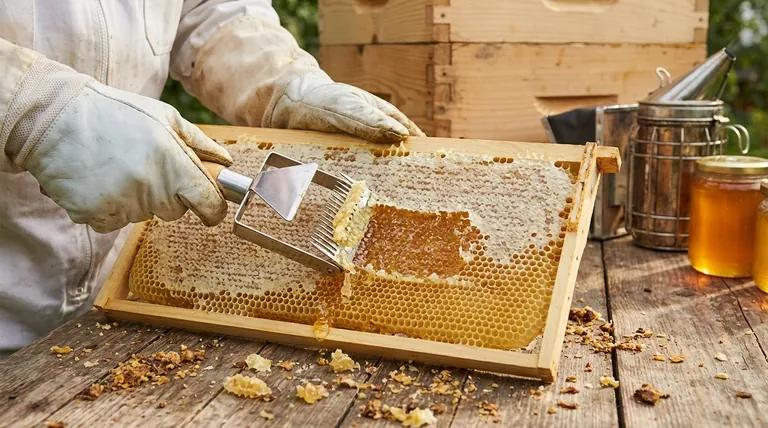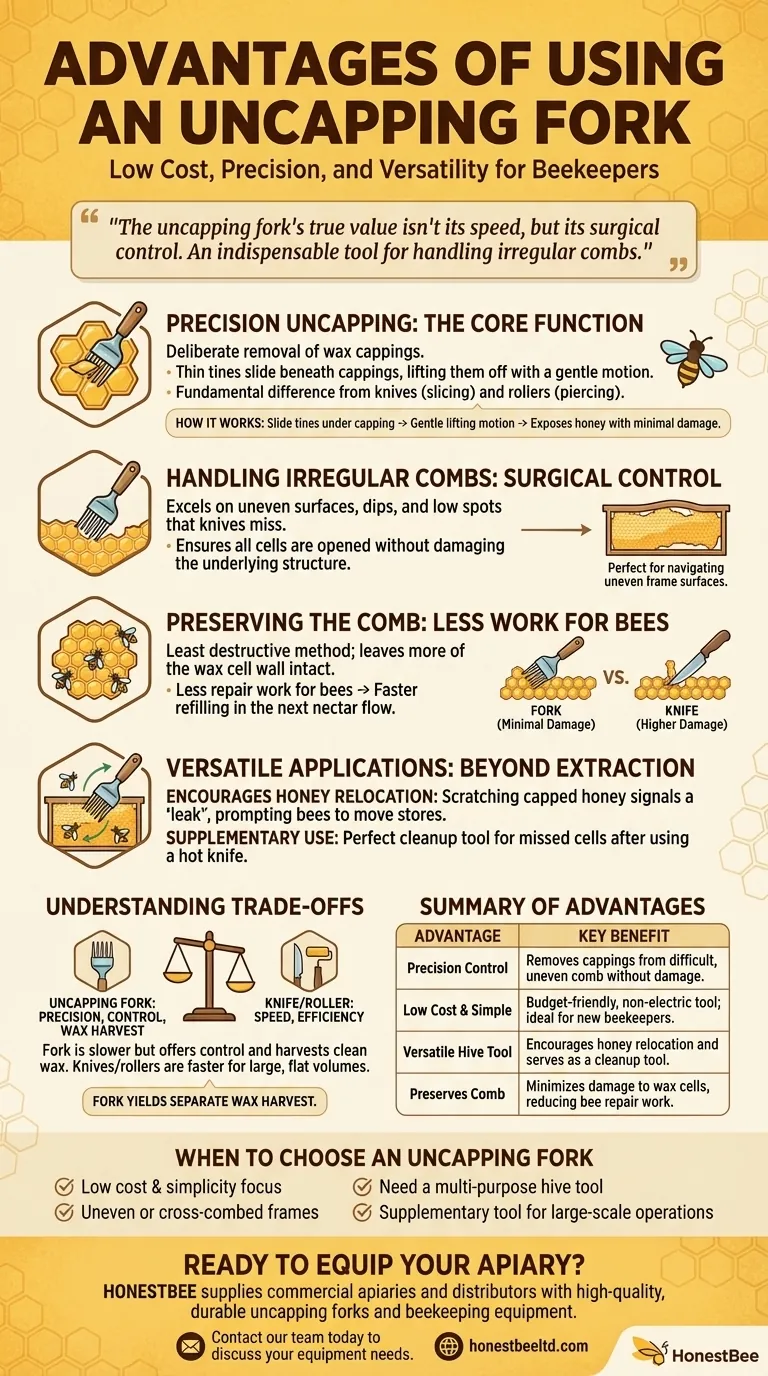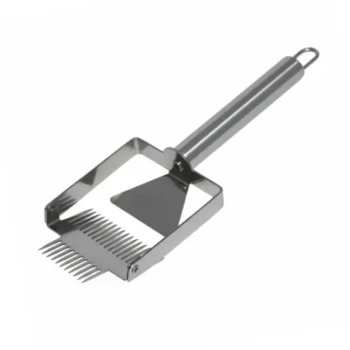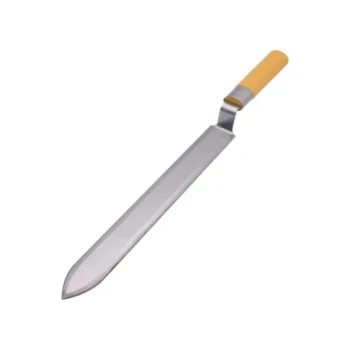The primary advantages of an uncapping fork are its low cost, precision, and versatility. Unlike electric knives, it requires no power and gives the beekeeper complete control to remove wax cappings from difficult or uneven sections of a honeycomb without damaging the comb structure.
The uncapping fork's true value isn't its speed, but its surgical control. It is an indispensable tool for handling irregular combs and serves unique purposes beyond simple honey extraction, making it essential for both new and experienced beekeepers.

The Core Function: Precision Uncapping
An uncapping fork is designed for the deliberate and careful removal of the wax cappings that bees build to seal cured honey in the comb.
How It Works
The tool features sharp, thin tines that you slide just beneath the wax cappings. With a gentle lifting motion, you "pick" or pry the cappings off the cells, exposing the honey for extraction.
This method is fundamentally different from an uncapping knife, which slices off the cappings, or a roller, which pierces them.
Handling Irregular Combs
This is where the fork truly excels. Honeycomb frames are often not perfectly flat. They can have low spots, dips, or uneven surfaces that a knife would miss entirely.
The fork allows you to get into these nooks and crannies, ensuring that all honey cells are opened with minimal damage to the underlying wax comb structure.
Preserving the Comb
Because you are carefully lifting the cappings from the top of the cell walls, a fork is one of the least destructive uncapping methods. This leaves more of the drawn-out wax cell intact.
Preserving the comb means the bees have far less repair work to do, allowing them to refill the cells with honey much faster in the next nectar flow.
A Versatile Tool Beyond Extraction
While its main purpose is for honey harvesting, the uncapping fork has other valuable applications inside the hive.
Encouraging Honey Relocation
Sometimes beekeepers need bees to move honey from one area of the hive to another (e.g., out of a brood box).
By lightly scratching the surface of capped honey with the fork, you signal to the bees that the stores are "leaking." Their instinct is to immediately clean it up and move the honey to a more secure location, typically higher up in the hive.
Supplementary Use
Even for beekeepers who primarily use a hot knife for speed, an uncapping fork is the perfect cleanup tool. It is used to quickly open any cells the knife missed on its pass.
Understanding the Trade-offs
No tool is perfect for every situation. The uncapping fork's precision comes at the cost of speed.
Speed and Efficiency
For a beekeeper with a large number of hives, using only an uncapping fork would be extremely time-consuming. An electric uncapping knife is significantly faster for processing dozens of flat, uniform frames.
Fork vs. Roller
An uncapping roller pierces the cappings with pins rather than removing them. This is very fast and leaves the wax on the frame for the bees to easily repair.
However, the fork allows you to harvest the clean wax cappings separately, which is a valuable product in itself. A roller does not yield this separate wax harvest.
When to Choose an Uncapping Fork
Your goals determine the right tool for the job. The uncapping fork is often used in conjunction with other tools.
- If your primary focus is low cost and simplicity: The fork is an excellent, budget-friendly, and non-electric starting point for new beekeepers with only a few hives.
- If you have uneven or cross-combed frames: The fork's precision is essential for salvaging honey from combs that a knife or other automated system cannot handle.
- If you want a multi-purpose hive tool: Its ability to scratch cappings for honey relocation makes it a valuable asset for hive management throughout the year.
- If you run a large-scale operation: View the fork as a supplementary tool for cleanup and difficult frames, not your primary instrument for bulk uncapping.
The uncapping fork earns its place on any beekeeper's tool list not for its speed, but for its control, reliability, and versatility.
Summary Table:
| Advantage | Key Benefit |
|---|---|
| Precision Control | Removes cappings from difficult, uneven comb without damage. |
| Low Cost & Simple | Budget-friendly, non-electric tool ideal for new beekeepers. |
| Versatile Hive Tool | Encourages honey relocation and serves as a cleanup tool. |
| Preserves Comb | Minimizes damage to wax cells, reducing bee repair work. |
Ready to equip your apiary with the right tools for a perfect harvest?
At HONESTBEE, we supply commercial apiaries and distributors with high-quality, durable uncapping forks and a full range of beekeeping equipment. Our wholesale-focused operations ensure you get the reliable tools you need to maximize efficiency and honey yield.
Contact our team today to discuss your equipment needs and see how we can support your beekeeping success.
Visual Guide

Related Products
- Stainless Steel Pivoting Honey Uncapping Fork with Plastic Handle
- Professional Honey Uncapping Fork Tool with Customizable Tine Options
- All Stainless Steel Double Sided Pivoting Honey Uncapping Fork
- Professional Bent Tine Honey Uncapping Fork with Ergonomic Grip
- All-Stainless Steel Pivoting Honey Uncapping Fork for Beekeeping
People Also Ask
- Why do you uncap honey? Unlock Your Harvest with Efficient Uncapping
- What to use to uncap honey? Choose the Right Tool for Your Apiary
- What is the recommended practice when using plain knives for uncapping? Master the Two-Knife Method for a Perfect Harvest
- What is the primary use of an uncapping fork in beekeeping? A Guide to Precision Honey Harvesting
- What are the common methods used by small-scale beekeepers to uncap honey frames?



















